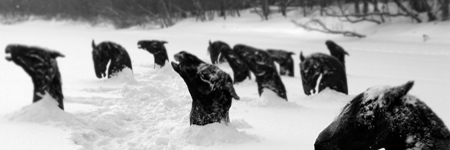Watching a Guy Maddin film is sort of like sifting through a stranger’s record collection. You get a feel for their tastes, recognize their deepest influences and soak an entire history without really knowing them. For Maddin, the silent era of filmmaking serves as a road map through his soul that we read in place of conventional dialogue or narrative. The films of Lang, Murnau, and Griffith, they emanate from every frame, telling his personal story through each vintage iris shot, every oddly-placed intertitle and even from the grainy black and white that appears aged and dated in its newness. His films certainly alienate a large number of audience members — they stand as far as one can get from commercial filmmaking without crossing the threshold into experimental cinema — but in terms of his passion for cinema, his film’s exhibit an undeniable charm.
Guy Maddin’s latest film, My Winnipeg, takes a slightly different approach than we’re used to from this maverick Canadian. Following a pseudo-documentary framework, it still adheres to that same silent era theme prevalent in his past work, but with a more introspective tinge. The film is literally about itself, about the way in which Maddin is attempting to disentangle his past from the checkered history of his city of origin. It resembles Micheal Moore without all the trumped-up drama, or This American Life without the linear narration.
For a film so brilliant in its design it does manage to stumble out of the gate, implementing the same foolhardy cinematic experimentalism that uses abrasive word repetition, incongruous intertitles and jarring superimpositions to get under the audience’s skin. But it begins to coalesce into something more substantial and less meandering when Maddin attempts to reenact scenes from his childhood using what he claims is his actual mother and some hired actors to play his siblings. Rather than coming across as vain or self-obsessed, these moments display an odd sense of humor (the father buried under the living room rug, the crazy new tenant of his childhood home that refuses to leave), and their astounding meta-structure add an extra layer of depth to the film.
As one can imagine, the film is terribly anecdotal, but not annoyingly so. It follows a certain rhythm. Typically he’ll divulge a secret occurrence from his past, find some way to tie it in with the history of the city and then explore one of the many oddities that have come out of Winnipeg over the last century. Whether its the governmental corruption, the disenfranchisement of the Winnipeg Jets (yes, the movie spends a great deal of time discussing hockey!) or the death of hundreds of horses who froze solid in a river with their heads still protruding from the ice in twisted agony, each story could be a film unto itself.
As the oddball tales pile up, I suspect so does the audience’s incredulous attitude toward them. Some of the stories sound plausible, others — such as the law in Winnipeg that states that no old signage can be destroyed — feel invented. Telling is the fact that the woman he claims to be his real life mother in the film is actually played by actress Ann Savage.
I won’t say which stories are true and which are simply tall tales because I feel it’s more fun to track them down on your own. In any case, it’s not as if Maddin is attempting to pull one over on the audience and manufacture truth for his own designs (much like Micheal Moore does). Many of his stories are quite obviously fabricated, but there’s a kernel of truth to even the most absurd stories in My Winnipeg and the underlying theme of the project makes sense when you take the stories as part of an overarching narrative theme: the demolition of a city’s personal history.
One aspect of Winnipeg that Maddin’s harps on throughout is this notion of the general sleepiness of Winnipeg’s citizens. Winnipeg has 10 times the sleepwalking rate of any other city, he says. Is it true? Does it matter? Not really. What’s important is the message Maddin seeks to convey. How true it is that we sleepwalk through the destruction of our own heritage, oblivious to the obliteration of the buildings and landscape that shaped us as youths. It’s terribly nostalgic, but for Maddin — and many of us — it’s also terribly tragic.
Tags: Canada, Dead Horses, Gay Bison!, Guy Maddin, Michael Moore, My Winnipeg, Silent Film, Sleepwalking, Winnipeg, Winnipeg Jets

Saturday, August 2, 2008 at 9:11 pm |
I agreed with you